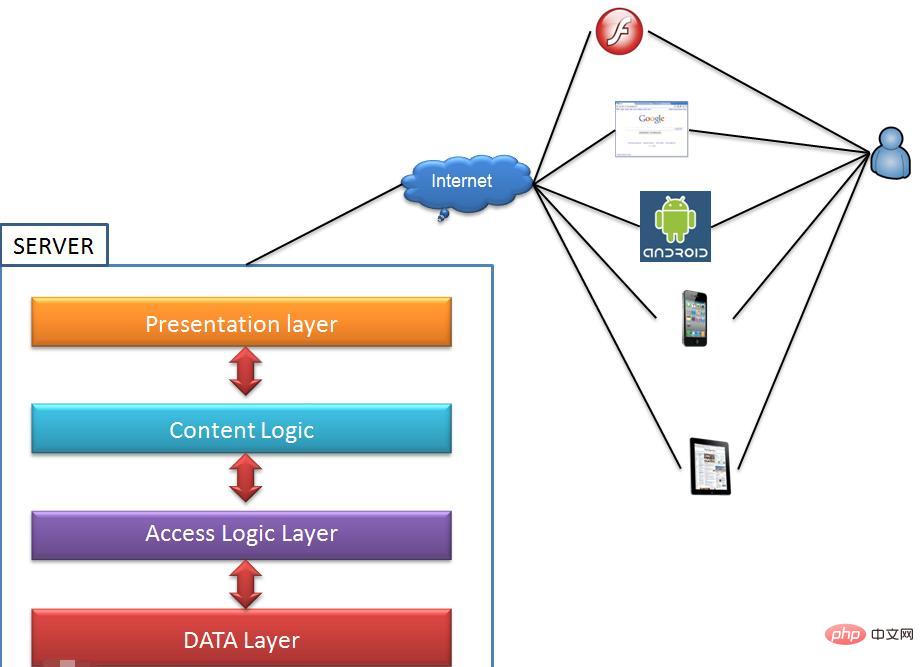The PHP framework is an infrastructure that can improve development efficiency, create more stable programs, and reduce developers' repetitive coding during the project development process; the PHP framework is an infrastructure that integrates the development processes of different Web systems. The common features and general functions are abstracted to form the basic architecture for developing Web programs.

The operating environment of this tutorial: Windows 7 system, PHP version 8.1, Dell G3 computer.
What is php framework?
The PHP framework is an infrastructure that can improve development efficiency, create more stable programs, and reduce developers from repeatedly writing code during the project development process. The PHP framework abstracts the common and common functions in the development process of different Web systems to form the basic architecture for developing Web programs.
When developing Web systems, if developers conduct secondary development based on the PHP framework, they can greatly simplify the development process and quickly implement system functions. The PHP framework can promote the rapid development of Web systems, save time, reduce the amount of repeated code, and help beginners create standardized and stable Web systems.
php frameworks include: thinkPHP, laravel, yii, CakePHP, CodeIgniter, Zend, Symfony, Yii2, Phalcon, etc.

Framework, that is, Framework, is actually a semi-finished product of a certain application, or a series of components for people to choose to complete our own applications. In other words, using a framework to develop a program is like performing on a stage that has been set up by others. You don't have to worry about the cumbersome and low-level things like setting up a stage, so that you can devote yourself to how to perform better. For example, Microsoft's .NET Framework, using it to develop Windows applications will be much more efficient.
The same is true for the PHP development framework. The PHP development framework encapsulates the underlying operations and puts Web program development on the assembly line. In other words, PHP development framework helps facilitate Rapid Software Development (RAD). Using the PHP framework not only saves developers time, but also helps developers create more stable programs and reduces the developer's labor of repeatedly writing code. The PHP development framework allows developers to spend more time creating real Web programs instead of writing repetitive code.
PHP development framework mostly adopts the "Model-View-Controller" (MVC) architecture pattern. The MVC architecture first existed in desktop applications, where M refers to the data model, V refers to the user interface, and C refers to the controller. The purpose of using MVC is to separate the implementation code of M and V, that is, to isolate the business logic and the user interface. No matter which one changes, it will not affect the other. In the MVC architecture, the model is responsible for data, the view is responsible for presentation, and the controller is responsible for business logic. Essentially, MVC splits the development process of a program so that you can modify each independent part without affecting other parts, which makes writing PHP code faster and easier.
Recommended learning: "PHP Video Tutorial"
The above is the detailed content of What is a php framework?. For more information, please follow other related articles on the PHP Chinese website!

Hot AI Tools

Undress AI Tool
Undress images for free

Undresser.AI Undress
AI-powered app for creating realistic nude photos

AI Clothes Remover
Online AI tool for removing clothes from photos.

Clothoff.io
AI clothes remover

Video Face Swap
Swap faces in any video effortlessly with our completely free AI face swap tool!

Hot Article

Hot Tools

Notepad++7.3.1
Easy-to-use and free code editor

SublimeText3 Chinese version
Chinese version, very easy to use

Zend Studio 13.0.1
Powerful PHP integrated development environment

Dreamweaver CS6
Visual web development tools

SublimeText3 Mac version
God-level code editing software (SublimeText3)
 Comparison of the advantages and disadvantages of PHP frameworks: Which one is better?
Jun 04, 2024 pm 03:36 PM
Comparison of the advantages and disadvantages of PHP frameworks: Which one is better?
Jun 04, 2024 pm 03:36 PM
The choice of PHP framework depends on project needs and developer skills: Laravel: rich in features and active community, but has a steep learning curve and high performance overhead. CodeIgniter: lightweight and easy to extend, but has limited functionality and less documentation. Symfony: Modular, strong community, but complex, performance issues. ZendFramework: enterprise-grade, stable and reliable, but bulky and expensive to license. Slim: micro-framework, fast, but with limited functionality and a steep learning curve.
 Performance differences of PHP frameworks in different development environments
Jun 05, 2024 pm 08:57 PM
Performance differences of PHP frameworks in different development environments
Jun 05, 2024 pm 08:57 PM
There are differences in the performance of PHP frameworks in different development environments. Development environments (such as local Apache servers) suffer from lower framework performance due to factors such as lower local server performance and debugging tools. In contrast, a production environment (such as a fully functional production server) with more powerful servers and optimized configurations allows the framework to perform significantly better.
 PHP Frameworks and Microservices: Cloud Native Deployment and Containerization
Jun 04, 2024 pm 12:48 PM
PHP Frameworks and Microservices: Cloud Native Deployment and Containerization
Jun 04, 2024 pm 12:48 PM
Benefits of combining PHP framework with microservices: Scalability: Easily extend the application, add new features or handle more load. Flexibility: Microservices are deployed and maintained independently, making it easier to make changes and updates. High availability: The failure of one microservice does not affect other parts, ensuring higher availability. Practical case: Deploying microservices using Laravel and Kubernetes Steps: Create a Laravel project. Define microservice controllers. Create Dockerfile. Create a Kubernetes manifest. Deploy microservices. Test microservices.
 Integration of PHP frameworks with DevOps: the future of automation and agility
Jun 05, 2024 pm 09:18 PM
Integration of PHP frameworks with DevOps: the future of automation and agility
Jun 05, 2024 pm 09:18 PM
Integrating PHP frameworks with DevOps can improve efficiency and agility: automate tedious tasks, free up personnel to focus on strategic tasks, shorten release cycles, accelerate time to market, improve code quality, reduce errors, enhance cross-functional team collaboration, and break down development and operations silos
 PHP Frameworks and Artificial Intelligence: A Developer's Guide
Jun 04, 2024 pm 12:47 PM
PHP Frameworks and Artificial Intelligence: A Developer's Guide
Jun 04, 2024 pm 12:47 PM
Use a PHP framework to integrate artificial intelligence (AI) to simplify the integration of AI in web applications. Recommended framework: Laravel: lightweight, efficient, and powerful. CodeIgniter: Simple and easy to use, suitable for small applications. ZendFramework: Enterprise-level framework with complete functions. AI integration method: Machine learning model: perform specific tasks. AIAPI: Provides pre-built functionality. AI library: handles AI tasks.
 Which PHP framework offers the most comprehensive extension library for rapid development?
Jun 04, 2024 am 10:45 AM
Which PHP framework offers the most comprehensive extension library for rapid development?
Jun 04, 2024 am 10:45 AM
The PHP framework extension library provides four frameworks for selection: Laravel: Known for its vast ecosystem and third-party packages, it provides authentication, routing, validation and other extensions. Symfony: Highly modular, extending functionality through reusable "Bundles", covering areas such as authentication and forms. CodeIgniter: lightweight and high-performance, providing practical extensions such as database connection and form validation. ZendFramework: Powerful enterprise-level features, with extensions such as authentication, database connection, RESTfulAPI support, etc.
 Application of PHP framework in agile development and large-scale projects
Jun 04, 2024 pm 01:42 PM
Application of PHP framework in agile development and large-scale projects
Jun 04, 2024 pm 01:42 PM
The PHP framework is widely used in agile development and large-scale projects, providing advantages such as agility, scalability, and security. For example, in e-commerce websites, the Laravel framework can quickly create prototypes, handle complex business logic, ensure security, and extend functionality. By leveraging predefined components and design patterns, PHP frameworks facilitate developers to build scalable and well-maintained applications.
 Comparison of PHP framework and Python framework
Jun 05, 2024 pm 09:09 PM
Comparison of PHP framework and Python framework
Jun 05, 2024 pm 09:09 PM
PHP and Python frameworks differ in language features, framework ecology, and features. PHP is primarily used for web development and is easy to learn; Python has an extensive library ecosystem. Popular PHP frameworks include Laravel, CodeIgniter, and Symfony; Python frameworks include Django, Flask, and Web2py. In practical cases, Laravel uses the command line to generate blog models and views, while Django uses DjangoAdmin and Python scripts to create blogs.






